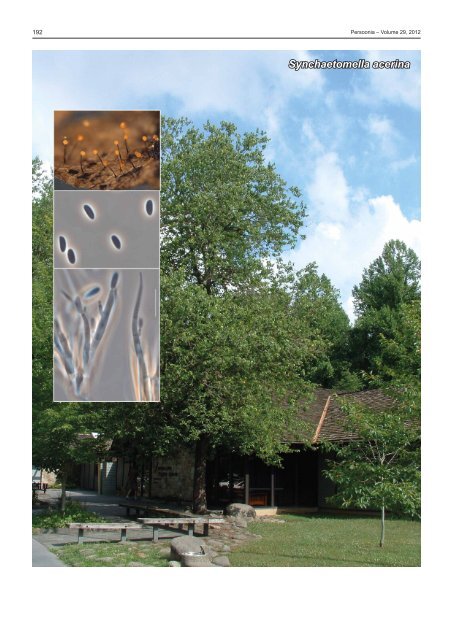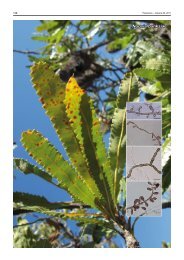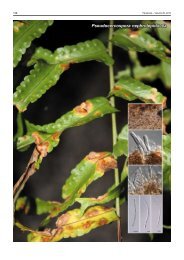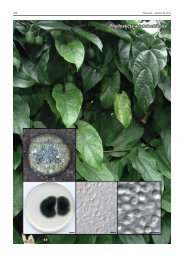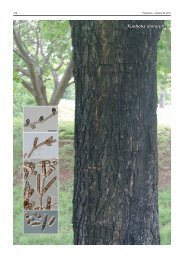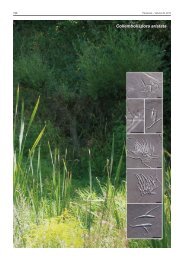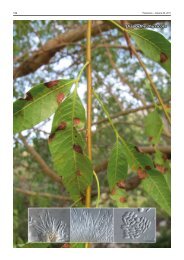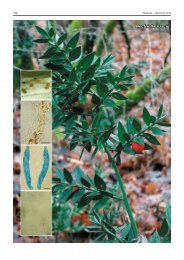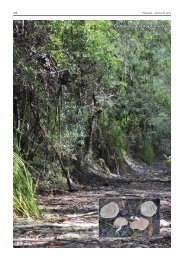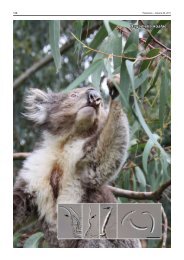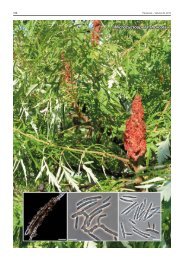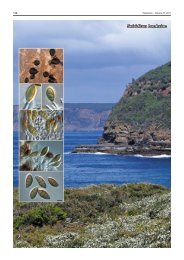Synchaetomella acerina - Fungal Planet
Synchaetomella acerina - Fungal Planet
Synchaetomella acerina - Fungal Planet
You also want an ePaper? Increase the reach of your titles
YUMPU automatically turns print PDFs into web optimized ePapers that Google loves.
192 Persoonia – Volume 29, 2012<br />
<strong>Synchaetomella</strong> <strong>acerina</strong>
<strong>Fungal</strong> <strong>Planet</strong> description sheets<br />
193<br />
<strong>Fungal</strong> <strong>Planet</strong> 150 – 20 December 2012<br />
<strong>Synchaetomella</strong> <strong>acerina</strong> Seifert, sp. nov.<br />
= Stilbella <strong>acerina</strong> Overh., Mycologia 35: 253. 1943. nom. inval. Art. 36.<br />
Etymology. Named after the genus of its host, duplicating the epithet<br />
proposed by the original discoverer of this species.<br />
Synnemata 250–825 µm tall, subulate, capitate, slender, 30–<br />
50 µm wide at the base, narrowing to 20–40 µm wide, black or<br />
dark brown, fading below the capitulum, usually unbranched,<br />
solitary, scattered or gregarious, sometimes associated with<br />
necrotic leaf spots of a Phyllosticta sp. Hyphae of stipe in two<br />
zones: marginal hyphae 2–3 µm wide, golden brown, unbranched,<br />
with walls up to 1 µm thick, sometimes seta-like and<br />
projecting into the capitulum and supporting the conidial mass;<br />
core hyphae 2–2.5 µm wide, hyaline, branching in the capitulum<br />
to give rise to the conidiophores. Conidiophores biverticillate<br />
or terverticillate, with terminal branches comprising 2–3 conidiogenous<br />
cells in an acropleurogenous chain; metulae 7–11<br />
× 1.5–2 µm. Conidiogenous cells phialidic; terminal phialides<br />
7–13 × 1–2 µm, subulate or acerose; intercalary phialides 6–9<br />
× 1–2.5 µm, cylindrical with a lateral, apically directed, terminal<br />
conidiogenous extension, 1–11.5 µm long, usually longest<br />
near the base of the chain; periclinal thickening and collarettes<br />
not seen. Conidial mass globose, at first hyaline, becoming<br />
white, usually orange when dry, sometimes white, yellow, or<br />
red, about 75–125 µm diam when dry. Conidia 5–7.5(–9.5) ×<br />
1.5–2.5(–3) µm (6.53 ± 0.06 × 2.37 ± 0.02, n = 25), aseptate,<br />
allantoid to ellipsoidal, hyaline.<br />
Culture characteristics — Typical synnemata develop on<br />
oatmeal agar, as do sessile conidiomata with identical conidiophores<br />
and conidia. Mononematous conidiophores, similar to<br />
those in conidiomata, are produced on the agar surface. There<br />
is more variation in conidial size than is seen on the natural<br />
substrate. On 2 % malt extract agar, parts of the colony are<br />
yeast-like, with irregularly shaped yeast cells. Other parts of the<br />
colony have a mycelial, micronematous anamorph, perhaps<br />
a degenerated version of conidiophores seen in conidiomata.<br />
Synnemata that develop in a damp chamber are often apically<br />
branched 1–4 times.<br />
Notes — The hyphomycete genus <strong>Synchaetomella</strong> is<br />
based on S. lunatospora, a species with falcate, 1-septate conidia,<br />
which was originally isolated from leaf-litter collected in<br />
Singapore (Decock et al. 2005). <strong>Synchaetomella</strong> <strong>acerina</strong> has<br />
similar conidiomata and conidiophore branching and is phylogenetically<br />
closely related, but differs by having aseptate, allantoid<br />
conidia, and occurs on living leaves of Acer rubrum. The<br />
lignicolous Exophiala calicioides also has acropleurogenous<br />
conidiogenous cells terminating in dark synnemata, but they<br />
have distinct annellations, and other characters are dissimilar<br />
to those of S. <strong>acerina</strong> (Ellis 1971, as Graphium).<br />
Stilbella <strong>acerina</strong> was invalidly described by Overholts (1943)<br />
without a Latin diagnosis, and excluded from Stilbella by Seifert<br />
(1985) without redisposition. In 1984, park rangers at Great<br />
Smokey Mountains National Park sent us living leaves of Acer<br />
rubrum from near the park headquarters, where Overholts reported<br />
finding the fungus. To our surprise, the synnematous<br />
fungus emerged from the leaves when damp chambered, and<br />
was easily cultured. Twenty years after that, K. Hodge and her<br />
student R. Bennett of Cornell University recollected the fungus<br />
again during a foray of the Mycological Society of America in<br />
the same park, providing the specimen used as the holotype of<br />
the species here.<br />
<strong>Synchaetomella</strong> belongs to the complex of anamorph genera<br />
including Chaetomella, Hainesia, Pilidium and Sphaerographium<br />
(Rossman et al. 2004). These genera have species with<br />
similar conidia and phialidic conidiogenous cells that develop<br />
in acropleurogenous chains. They differ primarily in the nature<br />
of their conidiomata, which in the other genera are coelomycetous.<br />
The addition of S. <strong>acerina</strong> to the complex calls into<br />
question the monophyly of these genera as presently circumscribed,<br />
but the species clearly belongs to <strong>Synchaetomella</strong><br />
morphologically, based on its synnematous conidiomata.<br />
Supplementary material in MycoBank includes line drawings<br />
of S. <strong>acerina</strong> and its yeast-like form in vitro.<br />
Typus. USA, Tennessee, Gatlinburg, Great Smokey Mountains National<br />
Park, Cataloochee Campground, on leaves of Acer rubrum, 15 July 2004,<br />
R. Bennett (holotype DAOM 242271, culture ex-type CCFC 242271); ITS<br />
sequence GenBank JX989830, LSU sequence GenBank JX989831, SSU<br />
sequence GenBank JX989832, Cox1 sequence GenBank JX989833,<br />
Myco Bank MB801762.<br />
Additional material examined. Same location and host, Park Headquarters<br />
Building, L.O. & F.M. Overholts, 18 Aug. 1939 (PAC 22851, holotype of<br />
Stilbella <strong>acerina</strong> nom. inval.); Park Headquarters Building, D.H. DeFoe, 27<br />
June 1984 (culture CBS 543.84).<br />
Colour illustrations. Acer rubrum near the Park Headquarters of the<br />
Great Smokey Mountains National Park (Andrew Miller), with synnemata,<br />
conidiophores and conidia from the type of <strong>Synchaetomella</strong> <strong>acerina</strong>.<br />
© 2012 Nationaal Herbarium Nederland & Centraalbureau voor Schimmelcultures<br />
Keith A. Seifert & Gerry Louis-Seize, Biodiversity (Mycology & Botany), Agriculture & Agri-Food Canada, 960 Carling Ave.,<br />
Ottawa, Ontario K1A 0C6, Canada;<br />
e-mail: keith.seifert@agr.gc.ca & louis16g@agr.gc.ca


